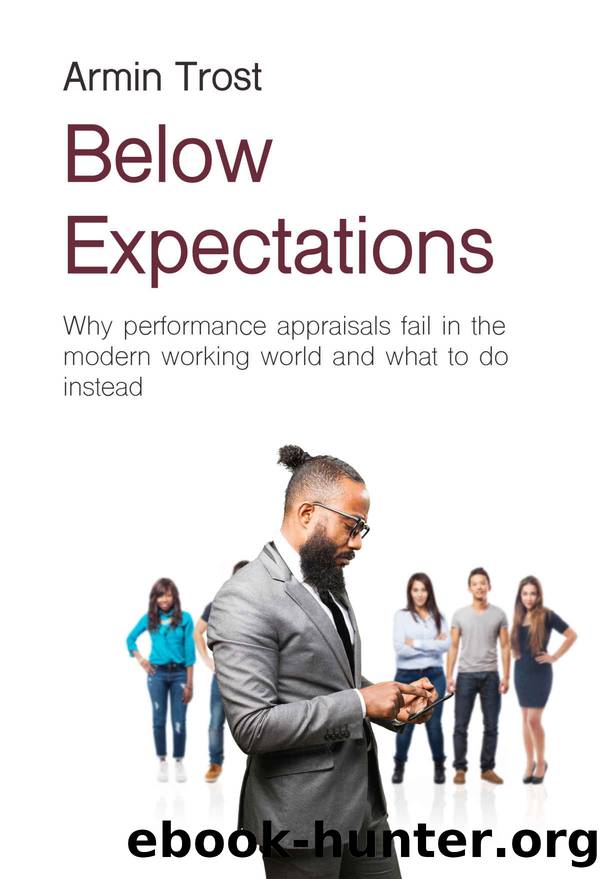Below Expectations: Why performance appraisals fail in the modern working world and what to do instead by Armin Trost

Author:Armin Trost [Trost, Armin]
Language: eng
Format: azw3
Published: 2016-03-04T16:00:00+00:00
“You’re an A-player to me”
At the end of chapter 4, we distinguished between two extreme worlds – the hierarchical and the agile world (cf. Figure 25). A general assumption can be made here that a classic, annual evaluation of individual employees conducted by the direct manager only works in the hierarchical model. This approach is more problematic in the agile model. Many statements have already been made in this respect regarding the framework conditions in chapter 4:
If the employees’ tasks are highly dynamic, i.e. the individual performance is dependent on the performances of others, this cannot be assessed in isolation by one single manager. If an employee is a high-performer, this is primarily because the system as a whole is conducive to achieving certain, outstanding results.
In an uncertain task environment, it is virtually impossible to articulate objective, long-term expectations in the form of binding targets – which significantly limits the possibilities for a performance evaluation later on.
If a manager is acting in the role of a coach or partner, there is a risk of a conflict of roles. A coach or partner cannot simultaneously be a judge with his/her employees, making future-relevant judgements about an employee, and documenting and forwarding these to a central authority, such as the HR department. The natural consequences are (largely invalid) inflationary evaluations skewed in a positive direction.
In knowledge-intensive areas primarily employing experts, direct managers will rarely be able to conduct a valid evaluation of an individual expert’s performance. They do not have enough technical knowledge to understand what the expert does, and what can be appropriately expected of him/her.
Performances are increasingly becoming the work of teams. “Placing individual employees on a pedestal”, so to speak, runs the risk of demotivating the rest of the team. This may result in rivalries and dysfunctional behavioural patterns, which ultimately reduce the performance of the team as a whole.
When employees work together in teams, their individual performances can only be evaluated if this individual performance can be identified. But in a dynamic, uncertain task environment, this is rarely possible, or only possible to a limited extent.
Managers will give more positive evaluations of employees they urgently need and on whom they are dependent. They naturally tend to indirectly use – and indeed abuse – a performance evaluation as an employee retention tool.
Download
This site does not store any files on its server. We only index and link to content provided by other sites. Please contact the content providers to delete copyright contents if any and email us, we'll remove relevant links or contents immediately.
Bullshit Jobs by David Graeber(3961)
Radical Candor by Kim Scott(2595)
I Am Right, You Are Wrong by Edward De Bono(2348)
23:27 by H. L. Roberts(2155)
Nomadland by Jessica Bruder(1976)
Average Is Over by Tyler Cowen(1763)
The Conflict Resolution Phrase Book by Barbara Mitchell & Cornelia Gamlem(1685)
Out of Our Minds: Learning to Be Creative by Ken Robinson(1635)
High-Impact Interview Questions by Victoria A. Hoevemeyer(1620)
The Ideal Team Player by Patrick M. Lencioni(1573)
An Everyone Culture: Becoming a Deliberately Developmental Organization by Robert Kegan & Lisa Laskow Lahey(1536)
The Asshole Survival Guide by Robert I. Sutton(1515)
Automatic Society by Bernard Stiegler(1475)
Who by Street Randy & Smart Geoff(1431)
Unleashed by Anne Morriss & Frances Frei(1430)
Who Moved My Cheese?: An Amazing Way to Deal With Change in Your Work and in Your Life by Johnson Spencer(1423)
42 Rules of Employee Engagement by Susan Stamm(1406)
96 Great Interview Questions to Ask Before You Hire by Paul Falcone(1363)
The Power of Disability by Al Etmanski(1298)
